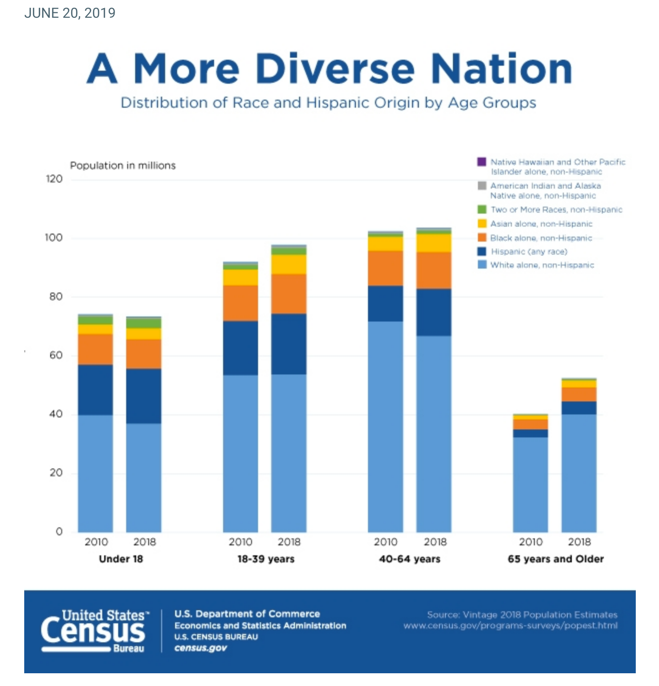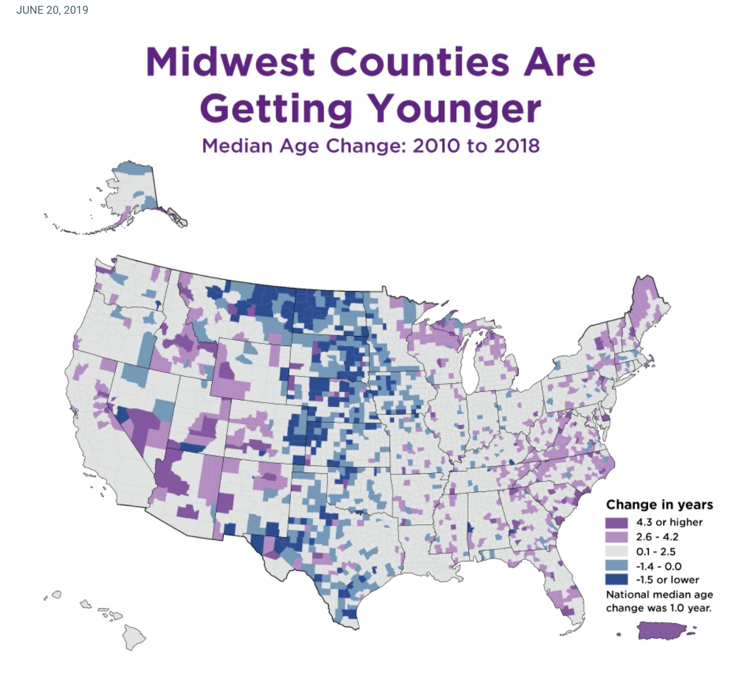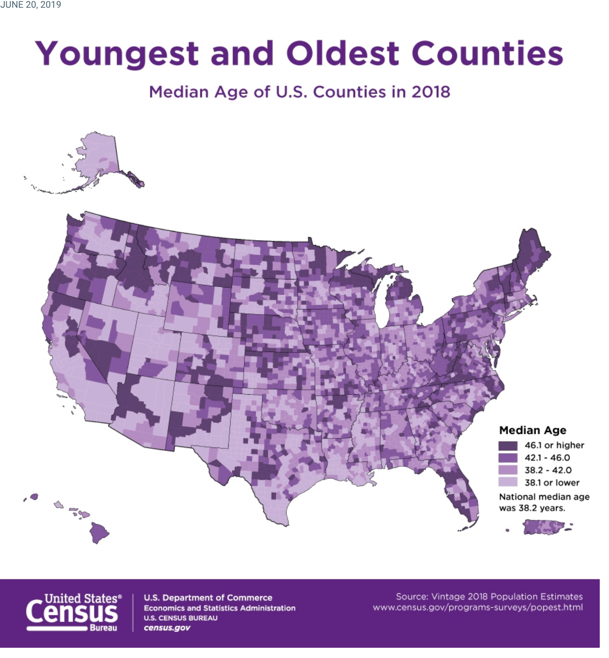2018 U.S. Population Estimates Show Aging Across Race Groups Differs, Nation Continues to Grow Older
From the U.S. Census:
The nation as a whole continues to grow older with the median age increasing to 38.2 years in 2018, up from 37.2 years in 2010. The pace of this aging is different across race and ethnicity groups, according to new 2018 Population Estimates by demographic characteristics for the nation, states and counties, released today by the U.S. Census Bureau.
From 2010 to 2018, the U.S. population’s median age increased by 1.0 years. Amongst the different race groups:
- The white alone-or-in-combination population increased by 1.0 years.
- The black or African American alone-or-in-combination population grew by 1.4 years.
- The American Indian and Alaska Native alone-or-in-combination population increased by 2.2 years.
- The Asian alone-or-in-combination population increased by 1.7 years.
- The Native Hawaiian and Other Pacific Islander alone-or-in-combination population increased by 2.6 years.
- The Hispanic (any race) population experienced an increase in median age of 2.2 years.
[Clip]
States
At the state level, North Dakota was the only state to see a decline in its median age, from 37.0 years in 2010 to 35.2 in 2018. Maine had the largest increase in median age this decade, going from 42.7 years in 2010 to 44.9 years in 2018, making it the state with the highest median age in the country. Utah had the lowest median age in 2018, at 31.0 years.
The share of the population age 65-and-older was 16.0 percent in 2018, growing by 3.2 percent (1,637,270) in the last year. The 65-and-older age group has increased 30.2 percent (12,159,974) since 2010. In contrast, during the same period, the under 18 population decreased by 1.1 percent, or a decline of 782,937 people.
CountiesOf the nation’s 3,142 counties, 2,566 (81.7 percent) had a higher median age in 2018 than in 2010. During this period, 16.7 percent (525) had median age decreases and 1.6 percent (51) saw no change. In 2018, out of all counties, 56.2 percent (1,767) had a median age between 40 and 49 years. Among those counties with populations of 20,000 or more in 2017 and 2018, Sumter County, Florida, had the highest median age (67.8) and Madison County, Idaho, had the lowest median age (23.2)
Changing Nation
As the nation continues to grow older, it is also changing by race and ethnicity. View our graphic on the age and race distribution from 2010 to 2018 to see how the nation has grown more diverse. References below to the race and ethnicity compositions are for race-alone-or-in-combination groups or Hispanic (any race) unless otherwise specified.
- Of the 50 states and the District of Columbia, 20 had a white population of 5.0 million or more, 21 were between 1.0 million and 4.9 million, nine were between 500,000 and 999,999, and one, the District of Columbia, had a population between 100,000 and 499,999.
- In 2018, 18 states had a black population greater than or equal to 1.0 million.
- California was the only state to have an Asian population larger than 5 million, at 6,890,703 in 2018. New York (1,922,974) and Texas (1,688,966) were the only two states that had a population between 1.0 million and 4.9 million.
- The American Indian and Alaska Native population was over 1.0 million in only one state, California, at 1,089,694 in 2018.
- In 2018, 36 states and the District of Columbia had a Native Hawaiian and Other Pacific Islander population that was less than 20,000. The two states with the largest Native Hawaiian and Other Pacific Islander populations in 2018 were Hawaii (382,261) and California (363,437).
- In 2018, the Hispanic population was between 100,000 and 499,999 in 20 states. Among the states and the District of Columbia, 10 states had a Hispanic population of 1.0 million or more. California (15,540,142), Texas (11,368,849), and Florida (5,562,417) were the only states that had populations of 5.0 million or more.
The Hispanic Population (of any race)
- The Hispanic population in the United States grew by 2.0 percent (1,164,289) between 2017 and 2018.
- In 2018, the Hispanic population was greater than or equal to 50,000 in 5.6 percent (177) of counties and less than 100 people in 5.5 percent (173) of counties. Of counties with populations of 20,000 or more in 2017 and 2018, the Hispanic population had the fastest growth in Liberty County, Texas, increasing by 11.4 percent (2,369).
- The Hispanic population was the largest in Los Angeles County, California, with a population of 4.9 million in 2018. The largest numeric growth between 2017 and 2018 was in Maricopa County, Arizona, increasing by 34,395 (2.6 percent) people.
The Black or African American Population
- In 2018, 740 of the 3,142 counties (23.6 percent) had a black or African American population between 1,000 and 4,999 people and 24.1 percent (756) of counties had a black or African American population between 100 and 499 people.
- Cook County, Illinois, had the largest black or African American population, which was about 1.3 million in 2018. Harris County, Texas had the largest numeric increase between 2017 and 2018, gaining 14,017 (1.5 percent) people.
- Of counties with a total population of 20,000 or more in 2017 and 2018, the black or African American population had the fastest increase in Ellis County, Texas, growing by 9.0 percent (1,799) between 2017 and 2018.
The Asian Population
- In 2018, 2.7 percent (86) of counties had an Asian population of 50,000 people or more. The Asian population was less than 1,000 people in 73.1 percent (2,297) of counties.
- Los Angeles County, California, had the largest Asian population in 2018 (1,720,889). King County, Washington, had the largest numeric increase in the Asian population, increasing by 23,932 (5.1 percent) between 2017 and 2018.
- Among counties with a total population of 20,000 or more in 2017 and 2018, the Asian population grew the fastest in Forsyth County, Georgia, increasing by 11.5 percent (3,734) between 2017 and 2018.
The American Indian and Alaska Native Population
- In 2018, 20 counties (0.6 percent) had an American Indian and Alaska Native population of 50,000 or more. Also in 2018, 635 counties (20.2 percent) had an American Indian and Alaska Native population between 1,000 and 4,999 and 1,272 (40.5 percent) counties had an American Indian and Alaska Native population that was between 100 and 499. The American Indian and Alaska Native population was less than 1,000 people in 2,219 (70.6 percent) counties.
- Los Angeles County, California had the largest American Indian and Alaska Native population in 2018 (231,340). Maricopa County, Arizona, had the largest numeric increase, growing by 3,745 (2.4 percent).
- Among counties with a total population of 20,000 or more in 2017 and 2018, the American Indian and Alaska Native population had the fastest growth in Clark County, Nevada, increasing by 3.5 percent (1,690) between 2017 and 2018.
The Native Hawaiian and Other Pacific Islander Population
- In 2018, only three (0.1 percent) counties had a Native Hawaiian and Other Pacific Islander population of 50,000 or more — these were Honolulu County (245,043) and Hawaii County (70,910) in Hawaii, and Los Angeles County, California (67,730). In 2018, 578 (18.4 percent) counties had a population between 100 and 499 people and 2,217 (70.6 percent) counties had a Native Hawaiian and Other Pacific Islander population that was less than 100 people.
- Honolulu County, Hawaii, had the largest Native Hawaiian and Other Pacific Islander population at 245,043 people in 2018. Clark County, Nevada, had the largest numeric growth, increasing by 1,458 between 2017 and 2018.
- Among counties with a population of 20,000 or more in 2017 and 2018, Pierce County, Washington, had the fastest Native Hawaiian and Other Pacific Islander population increase, growing by 4.9 percent (1,085) between 2017 and 2018.
The White Population
- The white population remained the largest group in the nation at 78.9 percent (258,080,572), and had the largest numeric increase from 2017 to 2018 (1,055,588).
- In 2018, the white population was greater than or equal to 50,000 in 906 (28.8 percent) counties and between 10,000 and 49,999 people in 1,390 (44.2 percent) of counties. In 2018, 48 (1.5 percent) counties had a white population that was less than 1,000 people.
- Los Angeles County, California, had the largest white population, at 7.4 million in 2018. Maricopa County, Arizona had the largest increase in the white population between 2017 and 2018, growing by 60,749 (1.6 percent).
- Among counties with a population of 20,000 or more in 2017 and 2018, Williams County, North Dakota, had the fastest growth in the white population at 5.3 percent (1,596) between 2017 and 2018.
Resources
For additional information about population changes by age and for each race or ethnic group, view our detailed tables (via FactFinder). This is the last release of the population estimates for 2018.
Previous estimates included national, county, metro area, city and town population estimates. These estimates are as of July 1, 2018, and therefore do not reflect the effects of Hurricane Florence in September 2018, Hurricane Michael in October 2018, and the California Wildfires. For information on how the national population is projected to change through 2060, view our previous release, Older People Projected to Outnumber Children for First Time in U.S. History
Summary Data Tables
Estimates of the Components of Resident Population Change by Race and Hispanic Origin for the United States: April 1, 2010 to July 1, 2018
Annual Estimates of the Resident Population by Sex, Single Year of Age, Race, and Hispanic Origin for the United States: April 1, 2010 to July 1, 2018
Annual Estimates of the Resident Population by Single Year of Age and Sex for the United States, States, and Puerto Rico Commonwealth: April 1, 2010 to July 1, 2018
Annual Estimates of the Resident Population by Sex, Age, Race, and Hispanic Origin for the United States and States: April 1, 2010 to July 1, 2018
Annual Estimates of the Resident Population by Sex, Age, Race Alone or in Combination, and Hispanic Origin for the United States and States: April 1, 2010 to July 1, 2018
Annual Estimates of the Resident Population by Sex, Race, and Hispanic Origin for the United States, States, and Counties: April 1, 2010 to July 1, 2018
Annual Estimates of the Resident Population by Sex, Race Alone or in Combination, and Hispanic Origin for the United States, States, and Counties: April 1, 2010 to July 1, 2018
Annual Estimates of the Resident Population for Selected Age Groups by Sex for the United States, States, Counties, and Puerto Rico Commonwealth and Municpios: April 1, 2010 to July 1, 2018
Annual Estimates of the Civilian Population by Single Year of Age and Sex for the United States and States: April 1, 2010 to July 1, 2018
Annual State Resident Population Estimates for 5 Race Groups
(5 Race Alone or in Combination Groups) by Age, Sex, and Hispanic Origin: April 1, 2010 to July 1, 2018Annual State Resident Population Estimates for 6 Race Groups
(5 Race Alone Groups and Two or More Races) by Age, Sex, and Hispanic Origin: April 1, 2010 to July 1, 2018Annual County Resident Population Estimates by Age, Sex, Race, and Hispanic Origin: April 1, 2010 to July 1, 2018
Filed under: Data Files, News
About Gary Price
Gary Price (gprice@gmail.com) is a librarian, writer, consultant, and frequent conference speaker based in the Washington D.C. metro area. He earned his MLIS degree from Wayne State University in Detroit. Price has won several awards including the SLA Innovations in Technology Award and Alumnus of the Year from the Wayne St. University Library and Information Science Program. From 2006-2009 he was Director of Online Information Services at Ask.com.





